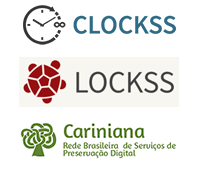Una experiencia didáctica en la enseñanza de la Biología desde la perspectiva del embarazo adolescente en comunidades ribereñas de Marajó- PA
DOI:
https://doi.org/10.20873/uft.rbec.e13279Resumen
RESUMEN. La presente investigación se desarrolló con el objetivo de indagar en qué medida una Secuencia Didáctica (DS) que involucre el concepto de “Reproducción Humana”, según la perspectiva histórico-cultural, puede contribuir a las comunidades ribereñas sobre el embarazo adolescente como ancla teórica, nos basamos en la teoría histórico-cultural, de Oliveira (1995), Rego (1995), Prestes (2010), Braz (2015) y otros teóricos que contribuyeron al debate. En la metodología, desarrollamos un enfoque cualitativo basado en Alves (1992) y Oliveira (1995), analizando una SD a partir de las miradas de Zabala (2011) y Cabral (2017). Para el análisis de las interacciones SD se trabajó con los supuestos teóricos de Góes (2000) conocidos como “Análisis Microgenético”. En los resultados, se observó que los participantes de la investigación mostraron una mayor comprensión de los conceptos sobre el tema "Reproducción Humana", reflejando significativamente el embarazo adolescente. Observamos que cuando utilizamos el conocimiento científico y el conocimiento cotidiano, hubo cambios en las actitudes hacia el tema. En este sentido, nuestro lente apuntó potencialidades en el aprendizaje cuando desarrollamos el SD desde la perspectiva histórico-cultural.
Descargas
Citas
Alves, A. J. (1992). A revisão da bibliografia em teses e dissertações: meus tipos inesquecíveis. Cadernos de Pesquisa, 81, 53-60. Recuperado de: https://publicacoes.fcc.org.br/cp/article/view/990
Barbosa, J. P. V. (2017). Análise microgenética de processos de ensino-aprendizagem em aulas de física conduzidas em ambientes de aprendizagem colaborativa (Tese de Doutorado). Universidade Federal de Minas Gerais, Belo Horizonte.
Brasil. (2020). Ministério da Mulher, da Família e dos Direitos Humanos. Programa Abrace o Marajó: Plano de ação 2020/2023. Recuperado de https://www.gov.br/mdh/pt-br/navegue-por-temas/abrace-o-marajo/plano-de-acao-do-programa-abrace-o-marajo-2020-2023-abordagem-por-eixos-e-linhas-de-acao
Braz, K. J. (2015). Criação de proposta de intervenção pedagógica na prevenção da gravidez na adolescência (Dissertação de Mestrado). Universidade Federal Fluminense, Niterói.
Cabral, N. F. (2017). Sequências Didáticas estruturação e elaboração. Belém: SBEM-PA.
CREASC. (2020). Centro de Referência e Assistência Social de Portel. Recuperado de: http://www.assistenciasocial.net.br/default.asp?Pag=1&Destino=Assistencia-Social&Estado=PA&Cidade=Portel
Dolz, J., Noverrage, M., & Scheneuwly, B. (2004). Sequências Didáticas para o ensino e a escrita de um procedimento. In Gênero orais e escritos na escola. Campinas: Mercado das letras.
Galagovs, L. R,. & Munõz, J. C. (2002). La distancia entre aprender palabras y aprehender conceptos. El entramado de palabras-concepto como un nuevo instrumento para la investigación. Enseñanza de las Ciencias, 20(1), 29-45.
Góes, M. C. R. (2000). A abordagem Microgenética na matriz histórico-cultural: uma perspectiva para o estudo da constituição da subjetividade. Cadernos Cedes, 50, 9-25. https://doi.org/10.1590/S0101-32622000000100002
Rego, T. C. (1995). Vygotsky: uma perspectiva histórico-cultural da educação. Petrópolis: Vozes.
Oliveira, M. F. (2015). Metodologia científica: um manual para realização de pesquisas em Administração. Catalão: UFG.
Oliveira, M. K. (1995). Vygotsky - aprendizado e desenvolvimento – um processo socio-histórico. São Paulo: Editora Scipione.
OMS. (2013). Organização Mundial da Saúde. O Estado da População mundial 2013: maternidade na infância. Nova York: Fundo das nações unidas para população.
Prestes, Z. R. (2010). Quando não é quase a mesma coisa: análise de traduções de Lev Semionovitch Vigotsky no Brasil repercussões no campo educacional (Tese de Doutorado). Universidade de Brasília, Brasília.
Silva, J. A. (2019). Transdisciplinaridade: abordagens significativas no ensino sobre sexualidade, gravidez na adolescência e infecções sexualmente transmissíveis no ensino médio (Dissertação de Mestrado). Universidade Federal de Minas Gerais, Belo Horizonte.
SINASC. (2018). Ministério da Saúde: MS/SMV/DASIS. Sistema de Informações sobre Nascidos Vivos. Recuperado de: https://svs.aids.gov.br/daent/centrais-de-conteudos/dados-abertos/sinasc/
Souza, C., & Zanlorenssi, G. (2022, 01 de julho). O número de meninas de até 14 anos que dão à luz no Brasil. Nexo Jornal Ltda. Recuperado de: https://www.nexojornal.com.br/grafico/2022/06/29/O-n%C3%BAmero-de-meninas-de-at%C3%A9-14-anos-que-d%C3%A3o-%C3%A0-luz-no-Brasil
Vigotsky L. S. (2018). Semenovich, 1896-1934. Imaginação e Criação na Infância: Ensaio psicológico, livro para professores. Tradução Técnica: Zoia Prestes e Elizabeth Tunes. São Paulo: Expressão Popular.
Vigotsky L. S. (2018). Sete Aulas de L. S. Vigotsky sobre os fundamentos da Pedologia/L. S. Vigotsky. Organização e Tradução Zoia Prestes, Elizabeth Tunes. Tradução Claudia Costa Guimarães Satana. Rio de Janeiro: Paper.
Vigotsky L. S. (2017). Linguagem, Desenvolvimento e Aprendizagem / Vigotsky Lev Semenovich, 1896-1934; Alex N. Leontiv. Tradução de: Maria da Pena VillaLobos-16ªEdição. São Paulo: Icoe.
Zabala, A. (1998). A prática educativa: como ensinar. Porto Alegre: Artmed.
Publicado
Cómo citar
Número
Sección
Licencia
Derechos de autor 2023 Hermison Bruno Baia Palheta, Fábio José da Costa Alves

Esta obra está bajo una licencia internacional Creative Commons Atribución 4.0.
Proposal for Copyright Notice Creative Commons
1. Policy Proposal to Open Access Journals
Authors who publish with this journal agree to the following terms:
A. Authors retain copyright and grant the journal right of first publication with the work simultaneously licensed under the Creative Commons Attribution License that allows sharing the work with recognition of its initial publication in this journal.
B. Authors are able to take on additional contracts separately, non-exclusive distribution of the version of the paper published in this journal (ex .: publish in institutional repository or as a book), with an acknowledgment of its initial publication in this journal.
C. Authors are permitted and encouraged to post their work online (eg .: in institutional repositories or on their website) at any point before or during the editorial process, as it can lead to productive exchanges, as well as increase the impact and the citation of published work (See the Effect of Open Access).














